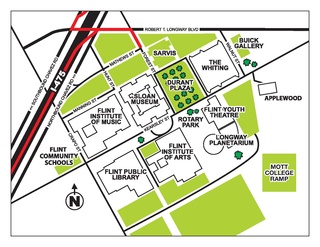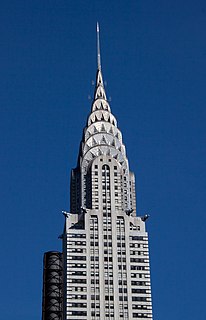
The New York University Tisch School of the Arts is the performing, cinematic and media arts school of New York University. Founded on August 17, 1965, Tisch is a training ground for artists, scholars of the arts, and filmmakers; the school merges the technical training of a professional school with the academic resources of a major research university to immerse students in their intended artistic disciplines. The school is divided into three Institutes: Performing Arts, Emerging Media, and the Kanbar Institute of Film & Television. Many undergraduate and graduate disciplines are available for students, including: acting, dance, drama, performance studies, design for stage and film, musical theatre writing, photography, game design and development, and film and television studies.
The Columbia University School of the Arts, also known simply as the School of the Arts or as SoA, is the graduate school of the university that offers programs in the fine arts. It offers the Master of Fine Arts (MFA) degrees in Film, Visual Arts, Theatre and Writing, as well as the Master of Arts (MA) degree in Film Studies. It works closely with the Arts Initiative at Columbia University (CUArts) and organizes the Columbia University Film Festival. Founded in 1948, the school is located in Morningside Heights, New York.

A movie palace is any of the large, elaborately decorated movie theaters built between the 1910s and the 1940s. The late 1920s saw the peak of the movie palace, with hundreds opened every year between 1925 and 1930. With the advent of television, movie attendance dropped and many movie palaces were razed or converted into multiple screen venues or performing arts centers.
Landmark Theatres is the largest specialised movie theatre chain in the United States dedicated to exhibiting and marketing independent and foreign films.

The Little Theatre in Rochester, New York, commonly known as "The Little" is a movie theatre located on historic East Avenue in downtown Rochester, New York and a modest non-profit multiplex specializing in art film, including independent and foreign productions outside the United States.

The Flint Cultural Center (FCC) is a campus of cultural, scientific, and artistic institutes located in Flint, Michigan, United States. The institutions located on the grounds of the FCC are the Flint Institute of Arts, Flint Institute of Music, Sloan Museum, Flint Public Library, Buick Gallery & Research Center, Robert T. Longway Planetarium, The Whiting, and the Bower Theatre. The campus and some institutions are owned by Flint Cultural Center Corporation.
The Carver Theatre, now formally known as the Carver Performing Arts Center, is a theater located in downtown Birmingham, Alabama. In its days as a motion picture theater, it was best known as a place where African-Americans could see first-run movies; during that time, only whites were allowed in most theaters because of segregation laws.

The Florida Theatre is a historic American movie theater located in Jacksonville, Florida. Opened in April 1927, it was added to the U.S. National Register of Historic Places on November 4, 1982. On April 18, 2012, the AIA's Florida Chapter placed the building on its list of Florida Architecture: 100 Years. 100 Places.

The Harris Theater is a landmark building at 809 Liberty Avenue in Downtown Pittsburgh, Pennsylvania's Cultural District.

The culture of Philadelphia goes back to 1682 when Philadelphia, Pennsylvania was founded by William Penn. Originally inhabited by the Lenape, Philadelphia was envisioned as a place where people could live without fear of persecution because of their religion. As a result, many Quakers, Mennonites, and others came to find refuge within the city. As Philadelphia grew into a major political and economic center of the United States, many different groups of religions and ethnicities flocked to the city. 19th and 20th century immigration and migration led to large concentrations of Irish, Italians, Germans, Asians, Puerto Ricans and African Americans. Philadelphia is still a major center of immigration, with large Chinese, Vietnamese, Korean, East African, Middle Eastern, Indian and Mexican immigrant populations, among others.

The Missouri Theatre, is a concert and entertainment venue in downtown Columbia, Missouri, occupying most of a city block between 9th street between Locust and Elm Streets. It was designed after the Opéra Garnier by the Boller Brothers, built in 1928, and is on the National Register of Historic Places. It is Columbia's only surviving pre-Depression movie palace and vaudeville stage. In 2011, the University of Missouri began a three-year lease of the facility. The Missouri Theatre is the resident home of the Missouri Symphony Orchestra, and is also frequently used by University of Missouri and civic groups. As of July 1, 2014, The University of Missouri took over ownership of the Missouri Theatre. It is one of the main performance venues for the University of Missouri School of Music.

True/False Film Fest is an annual documentary film festival that takes place in Columbia, Missouri. The Fest occurs on the first weekend in March, with films being shown from Thursday evening to Sunday night. Films are screened at multiple locations around downtown Columbia, including Ragtag Cinema, Jesse Hall, Missouri Theatre Center for the Arts, The Picturehouse, The Blue Note, The Globe, Rhynsburger Theater and the Forrest Theater in the Tiger Hotel.

Reel Affirmations (RA) is a non-profit, all-volunteer LGBT film festival in Washington, D.C. Founded in 1991 and held every year in mid-October, as of 2011 Reel Affirmations was one of the largest LGBT film festivals in the United States. Baltimore's Gay Life newspaper called it "one of the top three films festivals for the entire LGBT community." A 2007 guidebook claims it was one of the largest LGBT film festivals in the world. A listing of LGBT film festivals claims it is the largest all-volunteer film festival in the world.

Ragtag Cinema is a non-profit independent movie theater located on Hitt Street in Columbia, Missouri. The theater was founded by a group including Paul Sturtz and David Wilson in May 2000. The theater is the home of the Ragtag Film Society, a nonprofit organization which strives to champion film and other media arts to stimulate and encourage the culture of the community. It does so by spotlighting film as an art form, promoting media literacy, education and new ideas as well as supporting local artists. The theater also serves as a primary venue for the True/False Film Fest, which was launched by Sturtz and Wilson in 2004.
Cinefest Fairfield is an annual film festival since 2005 featuring short films by students, alumni and faculty of Fairfield University in Fairfield, Connecticut held in association with the Fairfield Community Theatre. The festival is sponsored by the Department of Visual and Performing Arts and showcases its innovative New Media Program.

Hong Kong Arts Centre is a non-profit arts organization established in 1977. It promotes contemporary performing arts, visual arts, film and video arts. It also provides arts education.

The Hanover Theatre for the Performing Arts in Worcester, Massachusetts, United States was originally built in 1904 as the Franklin Square Theatre regularly scheduling burlesque shows, Broadway touring shows and headline acts transitioning to showing silent films by 1912 when vaudeville magnate Sylvester Poli purchased the theatre from the estate of Pauline L. Taylor.

State Palace Theatre is a performing arts venue located in downtown New Orleans, Louisiana. It is located at the uptown lake corner of Canal Street and Rampart Street. The Saenger Theater is directly opposite the State Palace on Canal Street.

Disability in the arts is an aspect within various arts disciplines of inclusive practices involving disability. It manifests itself in the output and mission of some stage and modern dance performing-arts companies, and as the subject matter of individual works of art, such as the work of specific painters and those who draw.

The performing arts in Detroit include orchestra, live music, and theater, with more than a dozen performing arts venues. The stages and old time film palaces are generally located along Woodward Avenue, the city's central thoroughfare, in the Downtown, Midtown, and New Center areas. Some additional venues are located in neighborhood areas of the city. Many of the city's significant historic theaters have been revitalized.




















